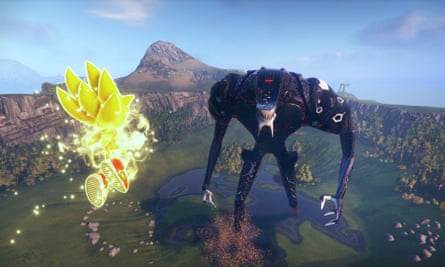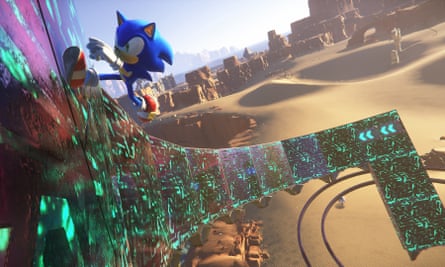A few years ago I wrote an article about how the original Sonic the Hedgehog games are examples of “incorrect game design” in that they break a lot of the rules laid down by that pesky genius Shigeru Miyamoto, creator of Super Mario. To my horror and frustration, a lot of Sonic fans interpreted this as a criticism of Sega when it was anything but, and my Twitter mentions were a no-go zone for several days afterwards.
So it is with some trepidation that I give Sonic Frontiers a three-star rating. But bear with me: you should play it. You should take a risk. It’s ridiculous and a bit broken, but it reminds me of the era in which Sega flourished; when Mega Drive TV commercials had kids screaming “Sega” at each other in school playgrounds; when its games were part of the Saturday morning miasma of cartoons, wrestling shows and poorly translated manga.
Billed as an open-world adventure, Frontiers is an idiosyncratic combination of The Legend of Zelda: Breath of the Wild and Shadow of the Colossus. Sonic is stranded on a series of weird island worlds as a result of a failed Dr Robotnik experiment, and now must free his friends from them, running around finding keys and other items to unlock Chaos Emeralds. It’s the sort of plot beloved of 1980s action cartoons such as Transformers, Thundercats and MASK, which is where Sonic’s sensibilities lie. Each of these islands ends with a giant boss battle, where you literally climb up the hulking figure to destroy it.
At first, the game looks like a sort of B-movie tribute to Breath of the Wild. The environments have that same muted naturalism, with craggy cliffs and sunlit woodland glades – only here, they’re more glitchy and unkempt. Many of the secrets and puzzles are revealed through exploration rather than map prompts or Ubisoft-style mission lists, and there’s even a discordant piano riff when you discover a hidden task – a familiar Zelda affectation.
But as you unlock elements of the map, looping sky rails, jump pads and pinball bumpers are added to the world, aiding speedy traversal and adding new secrets and challenges. Suddenly, you’re playing a proper 3D Sonic game. You can run really fast, jump on to a rail, do a loop-the-loop, eject yourself across a canyon, hit a pad to accelerate wildly and, for a few glorious seconds, lose control of the avatar as he zooms and rebounds, collecting golden rings with that ting-ting-ting sound that provides incredible nostalgic comfort to all Sonic veterans.
And here is the thing: this is a brilliant 3D Sonic game, in terms of input and response. The controls are perfect; the feel of guiding your character along theme park thrill rides is exhilarating and rewarding. It feels better than Sonic Adventure, a game I loved. Somehow it captures that interchange between control and abandon that has always characterised the series, but which has only previously worked to full effect in the 2D games. It’s an amazing achievement. And those who still crave classic 2D Sonic get to experience him in little cyber quests that pop up around the map and transport you into mini versions of classic Sonic levels and bonus stages. These are delightful asides for fans, and you can return several times to improve your performance and earn rewards.

But there is no getting away from the fact that Sonic Frontiers is a weird amalgam of retro sensibilities and modern ambitions. The worlds don’t have any life of their own, no purpose or permanence beyond Sonic’s quests and movement. The enemies scattered throughout each world get tougher as you go, and there are lots of different types, but they become boring after a while – especially as the combat is based very heavily around repetitive button-mashing. Even as you unlock new abilities on a skill tree, it sort of all merges into one muscle-spasming grind.
There are way too many things to collect: keys, purple coins, little creatures called Kokos, memory tokens, seeds, portal gears, gold rings … at times, exploring the islands feels like taking part in a hallucinogenic version of Supermarket Sweep, and keeping track of what each thing actually does is so taxing that it’s best just to give up and collect everything just in case. Systems just crop up without much explanation, as you run around trying to figure out what’s going on. Nothing makes much sense.
But, you see, this is the path that Sega has gone down with these games. Sonic is no longer in competition with Mario; Sonic is now a satire on the Nintendo principle that games should be utterly intuitive and function sensibly. There is no logic here, and that seems to be the point. The fact that you build a bizarre Sonic theme park on top of a Breath of the Wild landscape is symbolic of the inevitable victory of chaos over order. That is interesting. But admittedly, it’s probably not for everyone.
When a Sega marketing executive came up with the nonsense phrase “blast processing” to “explain” the technical capabilities of the Mega Drive, it’s now clear they experienced some sort of messianic premonition. Sonic Frontiers is blast processing in video game form: anarchic, careless, silly, exciting, meaningless, wonderful. What a daft and incredible ride.

